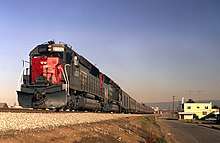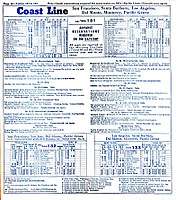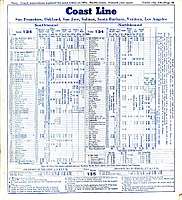Coast Daylight
 | ||||||||||||||||||||||||||||||||||||||||||||||||||||||||||||||||||||||||||||||||||||||||
|
Coast Daylight departing San Francisco in 1949. | ||||||||||||||||||||||||||||||||||||||||||||||||||||||||||||||||||||||||||||||||||||||||
| Overview | ||||||||||||||||||||||||||||||||||||||||||||||||||||||||||||||||||||||||||||||||||||||||
|---|---|---|---|---|---|---|---|---|---|---|---|---|---|---|---|---|---|---|---|---|---|---|---|---|---|---|---|---|---|---|---|---|---|---|---|---|---|---|---|---|---|---|---|---|---|---|---|---|---|---|---|---|---|---|---|---|---|---|---|---|---|---|---|---|---|---|---|---|---|---|---|---|---|---|---|---|---|---|---|---|---|---|---|---|---|---|---|---|
| First service | April 28, 1922 | |||||||||||||||||||||||||||||||||||||||||||||||||||||||||||||||||||||||||||||||||||||||
| Last service | May 19, 1974 | |||||||||||||||||||||||||||||||||||||||||||||||||||||||||||||||||||||||||||||||||||||||
| Successor | Coast Starlight | |||||||||||||||||||||||||||||||||||||||||||||||||||||||||||||||||||||||||||||||||||||||
| Former operator(s) |
Southern Pacific Amtrak | |||||||||||||||||||||||||||||||||||||||||||||||||||||||||||||||||||||||||||||||||||||||
| Route | ||||||||||||||||||||||||||||||||||||||||||||||||||||||||||||||||||||||||||||||||||||||||
| Start | Los Angeles | |||||||||||||||||||||||||||||||||||||||||||||||||||||||||||||||||||||||||||||||||||||||
| End | San Francisco | |||||||||||||||||||||||||||||||||||||||||||||||||||||||||||||||||||||||||||||||||||||||
| Train number(s) | 98/99 | |||||||||||||||||||||||||||||||||||||||||||||||||||||||||||||||||||||||||||||||||||||||
| Technical | ||||||||||||||||||||||||||||||||||||||||||||||||||||||||||||||||||||||||||||||||||||||||
| Track gauge | 4 ft 8 1⁄2 in (1,435 mm) standard gauge | |||||||||||||||||||||||||||||||||||||||||||||||||||||||||||||||||||||||||||||||||||||||
| ||||||||||||||||||||||||||||||||||||||||||||||||||||||||||||||||||||||||||||||||||||||||
The Coast Daylight, originally known as the Daylight Limited, was a passenger train on the Southern Pacific Railroad (SP) between Los Angeles and San Francisco, California, via SP's Coast Line. It was advertised as the "most beautiful passenger train in the world,"[1][2][3][4][5] carrying a particular red, orange, and black color scheme. The train operated from 1937 until 1974, one of the few passenger trains retained by Amtrak in 1971. Amtrak merged it with the Coast Starlight in 1974.
History
Southern Pacific
Southern Pacific introduced the Daylight Limited on April 28, 1922. The train operated on a 13-hour schedule between the Third and Townsend Depot in San Francisco and Central Station in Los Angeles, running on Fridays and Saturdays only. In 1922 and 1923 the train ran seasonally, beginning in April and ending in November. Daily operation began in July 1923. The SP shortened the running time to 12 hours for the 1924 season. Until the late 1920s it made no intermediate stops (except for servicing), the longest nonstop run in the world at that time. Its 12-hour schedule was two hours better than any other train on its route.[6]
The streamlined Daylight began on March 21, 1937, pulled by GS-2 steam locomotives on a 9 3⁄4-hour schedule. It was the first of the Daylight series that later included the San Joaquin Daylight, Shasta Daylight, Sacramento Daylight, and Sunbeam.

By June 30, 1939, the streamlined Daylights had carried 268.6 million passenger-miles on 781,141 train-miles for an average occupancy of 344 passengers.
The Coast Daylight ran behind steam until January 7, 1955, long after most streamliners had been powered by diesel.
A second train, the Noon Daylight, ran the same route 1940-42 and 1946-49 with a suspension during World War II. The original Coast Daylight became the Morning Daylight during this time.
In 1949 the Noon Daylight was replaced by the overnight Starlight using the same equipment. In 1956 coaches from the Starlight were added to the all-Pullman Lark and the Starlight was discontinued in 1957. Amtrak later revived the name for its Los Angeles to Seattle service known as the Coast Starlight.
A 1966 study by the Stanford Research Institute found that it cost the Southern Pacific $18.41 to transport a passenger on the Coast Daylight between Los Angeles and San Francisco, roughly twice that of air or bus service. Reasons given included the labor-intensiveness of rail service, and the fact that a single consist could make only one trip per day.[7]
Amtrak

The Coast Daylight was one of the trains retained by Amtrak when it commenced operation of most intercity passenger trains in the United States on May 1, 1971. It changed the northern terminus from San Francisco to Oakland, ending intercity service to San Francisco; passengers now had to connect to Southern Pacific's Peninsula Commute at San Jose. The train ran quad-weekly. The other three days of the week an extended Cascade, soon to be renamed the Coast Starlight, operated between San Diego and Seattle via Oakland. Amtrak marketed this dual operation as Coast Daylight-Starlight. On November 14, 1971, Amtrak extended the Coast Daylight's southern terminus from Los Angeles to San Diego. The Los Angeles–San Diego through-running ended the following April, replaced by a third San Diegan. In June 1973 Amtrak began running the combined Coast Daylight-Starlight daily. Positive response led to Amtrak to retain this service, and the Coast Daylight name was dropped on May 19, 1974.[8]
Amtrak has worked on plans for resuming Coast Daylight service from San Francisco to Los Angeles since the late 1990s. It may be merged with the existing Pacific Surfliner route, thus extending the line to San Diego. More specific plans have been made in the last few years.[9] The latest review of the possibility of service restoration was made on August 14, 2014, the San Luis Obispo Council of Governments (SLOCOG) organized and hosted a meeting between the Los Angeles – San Diego – San Luis Obispo (LOSSAN) Rail Corridor Agency and the Coast Rail Coordinating Council (CRCC), where substantial progress was made toward identifying which specific policy initiatives would be given priority so that restoration of the Coast Daylight service might be effectuated before the end of the decade.[10]
Legacy
On August 26, 1999, the United States Postal Service issued 33¢ All Aboard! 20th Century American Trains commemorative stamps showing five celebrated American passenger trains from the 1930s and 1940s. One of the stamps showed a GS-4 steam locomotive pulling the red-and-orange train along the coast.
One change was the elimination of the dining cars in the 1960s, replaced by Automat cars that offered food from vending machines instead of made-to-order meals in the dining cars, cutting the cost of the train's dining crew. This continued until 1971 when Amtrak took over and extended the route north to Portland and Seattle.
Equipment used
Passenger cars
A typical 1946 train:
- Baggage Chair Car Combine
- Articulated Chair Car (Pair)
- Articulated Chair Car (Pair)
- Articulated Chair Car (Pair)
- Articulated Dining Car (Triple Unit, consisting of a Coffee Shop car, Kitchen car, and Dining Room car)
- Chair Car
- Articulated Chair Car (Pair)
- Articulated Chair Car (Pair)
- Chair Car
- Tavern Car
- Parlor Car
- Parlor Observation Car
Twenty cars was the maximum consist.
A typical 1970 train:
- Baggage Car
- Chair Car
- Chair Car
- Chair Car
- Automat Car
- Chair Car
- Observation Chair Car
Gallery
- The train at Aromas, California
- The Daylight seen from Clark Lagoon near Santa Barbara, California.
- Daylight with diesel locomotives
- The observation car
 Coast Line consists and Time Tables 131-133, December, 1945
Coast Line consists and Time Tables 131-133, December, 1945 Coast Line Time Tables 134-135, December 1945
Coast Line Time Tables 134-135, December 1945
Locomotives
Two Coast Daylight locomotives survive: Southern Pacific 4449, a GS-4 steam locomotive which was a Bicentennial American Freedom Train engine in 1975-76, and Southern Pacific 6051, an EMD E9 diesel locomotive.
- Steam Locomotives
| Class | Wheel arrangement (Whyte notation) | Locomotive Numbers | Years of Daylight Service | Retired | Current Disposition |
|---|---|---|---|---|---|
| GS-2 | 4-8-4 | 4410–4415 | 1937–1941 | 1956 | No survivors[11] |
| GS-3 | 4-8-4 | 4416–4429 | 1938–1942 | 1957 | No survivors[12] |
| GS-4 | 4-8-4 | 4430–4457 | 1941–1955 | 1958 | One survives; 4449[13] |
| GS-5 | 4-8-4 | 4458 & 4459 | 1942–1955 | 1958 | No survivors |
- Diesel Locomotives
| Builder | Model | Locomotive Numbers | Years of Daylight Service | Retired | Current Disposition |
|---|---|---|---|---|---|
| ALCO | PA | 6005–6016, 6019–6045, 6055–6068 (A units); 5910–5915, 5918–5924 (B units) |
1953–1968 | 1968 | No survivors[14][15][16] |
| EMD | E7 | 6000–6004, 6017 (A units); 5900–5909, 5916 & 5917 (B units) |
1953–1968 | 1968 | No survivors[17][18] |
| EMD | E8 | 6018 | 1954–1968 | 1968 | No survivors |
| EMD | E9 | 6046–6054 | 1954–1971 | 1971 | One survives; 6051[19][20] |
| EMD | FP7 | 6446–6462 | 1953–1971; All but 6462 sold to Amtrak in 1971 | Early 1980s (with Amtrak) | No survivors[21][22] |
| EMD | SDP45 | 3200–3209 | 1967–1971; leased by Amtrak until 1974 | Early 1990s | No survivors[23][24][25] |
In fiction
The train appeared in the 1998 kids book The Great Railway Adventures Series 1, Adventure 1 The Daylight Limited which it is written by Lin Oliver and sponsored by Lionel, LLC and Learning Curve.[26]
See also
- Passenger train service on the Southern Pacific Railroad
References
- ↑ Solomon 2005, p. 49.
- ↑ "(untitled advertisement)". Life. 8 (9): 59. February 26, 1940 – via Google Books.
- ↑ "(untitled advertisement)". Good Housekeeping. International Magazine Company. 110: 144. 1940 – via Google Books.
- ↑ "(untitled)". Railroad History: 25, 145. 2007 – via Google Books.
- ↑ Beebe, Lucius; Clegg, Charles (1994). The Age of Steam: A Classic Album of American Railroading. New York: Promontory Press. p. 137. ISBN 0-88394-079-5 – via Google Books.
- ↑ Solomon 2005, pp. 32–33
- ↑ Hilton 1980, p. 11
- ↑ Goldberg 1981, pp. 16–17
- ↑ "Caltrain and the Coast Daylight - Coming to Monterey County". The Monterey Peninsula Toy Box. Retrieved 7 May 2015.
- ↑ "Status of Coast Daylight Service" (PDF). LOSSAN/CRCC Joint Meeting Agenda. August 14, 2014.
- ↑ Diebert & Strapac 1987, p. 236.
- ↑ Diebert & Strapac 1987, p. 237.
- ↑ Diebert & Strapac 1987, pp. 237-238.
- ↑ Percy, Richard A. (July 29, 2008). "Southern Pacific PA1/PB1-PA2/PB2". My Espee Modelers Archive. Retrieved May 22, 2017.
- ↑ "The Iconic Alco PA". American-Rails.com. Retrieved May 22, 2017.
- ↑ "Alco PA & PB". The Diesel Shop. Retrieved May 22, 2017.
- ↑ Percy, Richard A. (June 7, 2006). "Southern Pacific E7A/E7B". My Espee Modelers Archive. Retrieved May 22, 2017.
- ↑ "The EMD E7". American-Rails.com. Retrieved May 22, 2017.
- ↑ "The EMD E9". American-Rails.com. Retrieved May 22, 2017.
- ↑ Wilson, Jeff (2009). The Model Railroader's Guide to Diesel Locomotives. Waukesha, WI: Kalmbach Books. p. 35. ISBN 978-0-89024-761-7 – via Google Books.
- ↑ "The EMD FP7". American-Rails.com. Retrieved May 22, 2017.
- ↑ Percy, Richard A. (June 28, 2003). "EMD F units of the Southern Pacific, Cotton Belt and Texas and New Orleans". My Espee Modelers Archive. Retrieved May 22, 2017.
- ↑ "The EMD SD45 Series". American-Rails.com. Retrieved May 22, 2017.
- ↑ "Southern Pacific: Locomotives 3200-3209". Steve Sloan Train Photos. Retrieved May 22, 2017.
- ↑ Sarberenyi, Robert. "EMD's SD45 and SDP45- Original Owners". TrainWeb. Retrieved May 22, 2017.
- ↑ The Daylight Limited (Great Railway Adventures. Series 1, Adventure 1) Thriftbooks. Retrieved January 6, 2017
- Diebert, Timothy S. & Strapac, Joseph A. (1987). Southern Pacific Company Steam Locomotive Conpendium. Shade Tree Books. ISBN 0-930742-12-5.
- Goldberg, Bruce (1981). Amtrak--the first decade. Silver Spring, MD: Alan Books. OCLC 7925036.
- Hilton, George W. (1980). Amtrak: The National Railroad Passenger Corporation (PDF). Washington, DC: American Enterprise Institute for Public Policy Research. ISBN 0-8447-3369-5. OCLC 5777023.
- Solomon, Brian (2005). Southern Pacific Passenger Trains. St. Paul, Minnesota: MBI. ISBN 0-7603-1795-X. OCLC 56924935.
Further reading
- DeNevi, Don (1996). America's Fighting Railroads: A World War II Pictorial History. Pictorial Histories Publishing Company, Inc., Missoula, MT. ISBN 1-57510-001-0.
- Wright, Richard K. (1970). Southern Pacific Daylight: Train 98-99. RKW Publications, Sparks, NV.
External links
| Wikimedia Commons has media related to Coast Daylight (SP train). |